![]()
![]()
![]()
Use LEFT and RIGHT arrow keys to navigate between flashcards;
Use UP and DOWN arrow keys to flip the card;
H to show hint;
A reads text to speech;
60 Cards in this Set
- Front
- Back
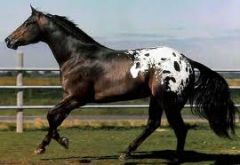
Color?
|
Appaloosa:
Basic colour usually roan with spots -Can be dark spots on white -Can be white spots on dark |
|
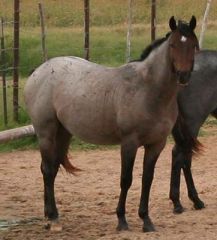
Color?
|
Bay Roan:
Defined generally as an even mixture of white and pigmented hairs that does not "grey out" or fade as the animal ages. Bay Roan is true roan on a bay coat. |
|

Color?
|
Black:
Everything must be black -can have white areas Any tan – classify as brown |
|
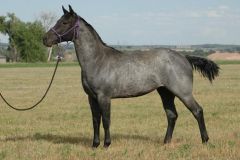
Color?
|
Blue Roan:
Blue Roan is true roan on a black coat. The mane, tail, head, and legs remain black, while the body takes on a greyish or bluish appearance. Do not confuse with grey. |
|

Color?
|
Brown:
Whole coat dark brown/black No distinguishing lines |
|
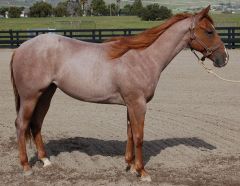
Color?
|
Chestnut (Red) Roan: roans with a chestnut background coat.
|
|
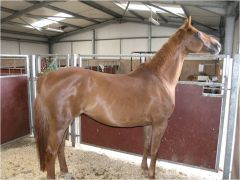
Color?
|
Chestnut:
-Reddish/yellow brown -Mane and tail usually chestnut but can be darker/lighter -Mane and tail can be flaxen |
|

Color?
|
Cream:
-Unpigmented skin -Iris minimal pigment -Eye pinkish or bluish appearance |
|
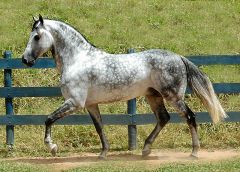
Color?
|
Dappled Grey:
"Dapple grey" is an intermediate stage not seen on all greys, but often considered highly attractive. It consists of a dark hair coat with "dapples", which are dark rings with lighter hairs on the inside of the ring, scattered over the entire body of the animal. Mosaic black and white hairs. Skin black. |
|
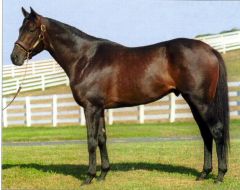
Color?
|
Dark Bay:
Bay is a hair coat color of horses, characterized by a reddish brown body color with a black mane, tail, ear edges, and lower legs. Bay horses range in color from a light copper red, to a rich red blood bay (the best-known variety of bay horse) to a very dark red or brown called dark bay, mahogany bay, black-bay, or brown (occasionally "seal brown"). |
|

Color?
|
Dun:
The classic Dun is a grey-gold or tan, characterized by a body color ranging from sandy yellow to reddish-brown. Dun horses always have a dark stripe down the middle of their back, a tail and mane darker than the body coat, and usually darker faces and legs. |
|

Color?
|
Flea-Bitten Grey:
Grey is a coat color of horses characterized by progressive silvering of the colored hairs of the coat. Most grey horses have black skin and dark eyes. Their adult hair coat is white, dappled, or white intermingled with hairs of other colors. Flea-bitten grey is a color consisting of a white hair coat with small speckles or "freckles" of red-colored hair throughout. |
|

Color?
|
Grey:
Grey is a coat color of horses characterized by progressive silvering of the colored hairs of the coat. Most grey horses have black skin and dark eyes. Their adult hair coat is white, dappled, or white intermingled with hairs of other colors. |
|
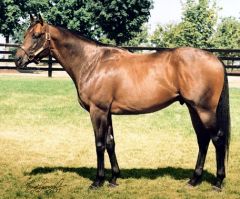
Color?
|
Light Bay:
Bay is a hair coat color of horses, characterized by a reddish brown body color with a black mane, tail, ear edges, and lower legs. Bay horses range in color from a light copper red, to a rich red blood bay (the best-known variety of bay horse) to a very dark red or brown called dark bay, mahogany bay, black-bay, or brown (occasionally "seal brown"). |
|

Color?
|
Palomino:
Palomino is a coat color in horses, consisting of a gold coat and white mane and tail. |
|

Color?
|
Piebald:
A piebald is an animal, such as a horse or ball python, that has a spotting pattern of large unpigmented (sometimes expressed as white) areas and normally pigmented (black) patches. |
|

Color?
|
Skewbald:
A skewbald horse has a coat made up of white patches on a non-black base coat, such as chestnut, bay, or any color besides black coat. |
|

Color?
|
Roan:
Horses with the roan pattern have an even mixture of white and colored hairs in the coat. These interspersed white hairs are more scattered or absent on the horse's head, mane, tail, and lower legs. |
|

Breed?
|
ARAB:
Origin: Breed is derived from the wild horses that occurred in the Arabian plain before it became a desert. Colour: Greys are common but other colours frequently |
|
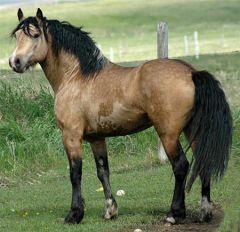
Breed?
|
WELSH COB:
Origin: Derived from the Welsh pony which was crossed with various English breeds, particularly the old English ‘trotter’ or ‘roadster’ to produce what was referred to as the ‘old Welsh cart horse’. Further crosses with Arabs and Thoroughbreds have resulted in the present day Welsh Cob. Colour: No special colour. Height: From 14 to over 15 hands. The general description is similar to that of the pony. It must be a strong vigorous animal with a good action. |
|

Breed?
|
WELSH PONY:
Origin: The Welsh pony has existed in a semi-wild state in the mountains of Wales for a great number of years. There has been some admixture of Arab and Thoroughbred blood but probably not sufficient to affect the general character of the breed. The Welsh Pony and Cob Society was founded in 1901. Colour: Greys, bays, browns, blacks, roans and chestnuts are all plentiful. Height: 12 hands is the maximum. |
|

Breed?
|
HIGHLAND PONY:
Origin: It is said that in the year 1535 James IV received a gift of a number of French horses from Louis XII in order to increase the size of the horses in the Scottish Highlands. These horses, which included Percherons, may be responsible for the large size of the present day Highland pony. Colour: Grey is the commonest colour, but black, brown and dun are generally preferred. An eel stripe (list or dorsal stripe) along the back is a typical feature. There should be no white markings. Height: 13-14.2 hands. |
|
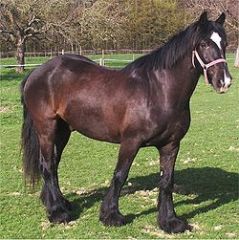
Breed?
|
Dales:
They usually have sturdy legs with dense bone and some feathering. The cannon bone can range from 8-9in. The hoof is usually of blue horn and is very strong. Dales Ponies are predominantly black or dark brown (a variation of bay), although some are grey or bay with the occasional blue or bay roan. The breed standard states Dales Ponies should be around the preferred height; being between 14 and 14.2 hands (hh). |
|
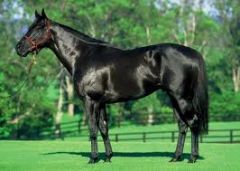
Breed?
|
ENGLISH THOROUGHBRED:
Origin: There is some doubt about the role that the native English horses played in the formation of the Thoroughbred. There is no doubt that the breed largely, if not entirely, stems from horses of Arab blood imported in the late 17th and early 18th centuries. Colour: Bays, browns and chestnuts predominate. Blacks and greys and uncommon. |
|

Type?
|
Warmblood:
Warmbloods are a group of middle-weight horse types and breeds. The term distinguishes these horses from both heavy draft horses ("cold bloods") and refined light saddle horses such as the Thoroughbred and Arabian ("hot bloods"). |
|

Body Type?
|
Cob:
Cob is a term used to describe a type of horse that is small, usually of a stout build, with strong bones, large joints, and steady disposition. The term refers to a body type of horse rather than a specific breed. In general terms, cobs are larger than ponies, standing 14.2 hands or taller, but are relatively small and compact, usually with somewhat short legs. |
|

Breed?
|
CLYDESDALE:
Origin: Developed in Clyde Valley by crossing the native horses with Flemish stallions. Clydesdale Horse Society founded in 1877. Colour: Dark brown or bay preferred, chestnuts and blacks do occur, with white stripe on face, dark coloured forelegs and white hind legs. Height: 16-17 hands. |
|

Breed?
|
SHIRE:
The largest of the heavy draught breeds. Origin: Probably the shire is the purest survival of the mediaeval Great Horse/British War Horse. Bred extensively in the Midlands and Eastern Counties extending from Yorkshire to the Thames. The forerunner of the present Shire Horse Society was founded in 1878. Colour: Blacks, greys, browns, bays. Height: Average 17 hands. |
|

Breed?
|
PERCHERON:
Origin: The Percheron horses originated in the small province of La Perche, situated on the eastern border of Normandy. First introduced into Great Britain during the First World War. The British Percheron Horse Society was formed in 1918. Colour: Grey or black with a minimum of white, often with silver mane and tail. Height: Stallions not less than 16.3 hands, mares 16.1 hands. |
|

Breed?
|
SHETLAND PONY:
Origin: One of the oldest breeds of pony in existence. Bred in Orkney and Shetland for over 1,200 years. There is no foreign blood in the make up of the Shetland pony. Colour: Very variable, brown is the most common colour. Height: Smallest British pony, average height is 40 inches, maximum 42 inches. |
|

Breed?
|
CONNEMARA:
Origin: Found in the west coast of Ireland. The original native horse has been crossed with horses from Spain, Africa and Arabia to produce the Connemara pony of today. More recently indiscriminate crossing has resulted in a preponderance of cross bred animals in many districts. Only in 1923 was a Society formed and attempts made to introduce a more systematic breeding policy. Colour: Mainly grey but black, bays, brown, duns and occasional roans and chestnuts occur. Height: 13-14 hands. |
|
|
Any white mark on the forehead.
|
Star
|
|
|
The narrow white marking down the face, not wider than the flat
anterior surface of the nasal bones. |
Stripe
|
|
|
A white marking covering almost the whole of the forehead between
the eyes and extending beyond the width of the nasal bones and usually to the muzzle. |
Blaze
|
|
|
Where the white covers the forehead and front of the face, extending
laterally towards the mouth. |
White Face
|
|
|
An isolated white marking situated between or in the region of the nostrils.
|
Snip
|
|
|
Where the white embraces both lips and extends to the region of the
nostrils. |
White Muzzle
|
|
|
A focal point into which the hairs seem to converge from different
directions. |
(Simple) Whorl
|
|
|
A focal point into which the hairs seem to converge from different
directions where the hair converges and piles up into a tuft. |
Tufted Whorl
|
|
|
Two opposing sweeps of hair meet from diametrically opposite
directions along a line. |
Linear Whorl
|
|
|
Two opposing sweeps of hair meet from diametrically opposite
directions along a line where the hair from each of the two directions rises up to form a crest. |
Crested Whorl
|
|
|
Two sweeps of hair meet along a line but the direction of flow of each
sweep is at an angle to the other so that together they form a feathered pattern. |
Feathered Whorl
|
|
|
Two opposing sweeps of hair meet along an irregular curving line.
|
Sinuous Whorl
|
|
|
This term should be used exclusively where there is such a lack of pigment, either partial or complete, in the iris as usually to give a pinkish-white or bluish-white appearance to the eye.
|
Wall-eye
|
|
|
Where white hairs are sparsely distributed through the coat or any part of the body.
|
Grey-ticked
|
|
|
Where small collections of white hairs occurs distributed irregularly in any part of the body.
|
Flecked
|
|
|
Where small, more or less circular, collections of hairs differing from the general body colour occur, distributed in various parts of the body.
|
Spots
|
|
|
This term should be used to describe any larger well-defined irregular areas of hairs differing from the general body colour.
|
Patch
|
|
|
Where there is striping on the limbs, neck, withers or quarters.
|
Zebra Marks
|
|
|
A dorsal band of black hairs which extends from the wither backwards.
|
List
|
|
|
How do you indicate white marks on a sketch?
|
Outlined in red with interior diagonal hatchmarks
|
|
|
How do you indicate whorls on a sketch?
|
A small St. Andrew's cross (x) in black. In the case of linear whorls, a cross is placed at the beginning of the whorl followed by a line showing direction.
|
|
|
How is a bordered mark indicated on a sketch?
|
A double ring
|
|
|
How is a flesh mark indicated on a sketch?
|
Completely shaded in red
|
|

Breed?
|
SUFFOLK PUNCH:
Origin: The breed originated in the County of Suffolk and was recognized as having distinct characteristics as far back as 1506. The Suffolk Horse Society was founded in 1877. Colour: Always chestnut usually with star or blaze. Height: 16-16.3 hands. |
|

Breed?
|
CLEVELAND BAY:
Origin: Developed in the North West part of Yorkshire as a general utility breed able to work on a farm, act as a pack horse and a saddle horse. They were in great demand as coach horses. Colour: Always a bay. White is not admissible apart from a very small star. Height: 15.3-16 hands. |
|

Breed?
|
HACKNEY:
Origin: In Norfolk in the 15th century a breed known as the Trotter was already well established. In the 14th century Arab-Spanish blood was introduced to produce the Hackney as we know it today. Colour: All colours. Height: 15 hands. |
|

Breed?
|
NEW FOREST PONY:
Origin: The New Forest comprises 60,000 acres of land between Southampton and the River Avon. Wild ponies have lived in this area for many hundreds of years. The modern New Forest pony is of mixed origin basically it was an ancient British pony type but many crosses have been made with Arabs and more recently with Highland, Exmoor, Dartmoor and Welsh ponies. A society was formed in 1906 and a Stud. Colour: Any colour but bays and browns predominate. Height: 12-14 hands. |
|

Breed?
|
DARTMOOR PONY:
Origin: Since these ponies have roamed Dartmoor in a semi-wild state for many centuries they are of very mixed composition but, until Shetland stallions were introduced in order to produce pit ponies, they were very consistent in type. The typical Dartmoor pony should have the following characteristics. Colour: Bay, brown and black preferred. Height: Must not exceed 12.2 hands. |
|

Breed?
|
EXMOOR PONY:
Origin: Exmoor, situated in North West Somerset, is a rugged tract of country. The harsh climate and poor winter grazing have resulted in the Exmoor pony being extremely hardy and strong. They live out on the moor throughout the year in a virtually wild state, the only gathering being in October when the foals are separated for sale. Because of the severe conditions under which these ponies live there has been little attempt to ‘improve’ them by crossing with Arab or Thoroughbred, with the result that the Exmoor is more true to type than any other pony apart from the Shetland. Colour: Dark brown or bay. Height: 12.2 hands. |

